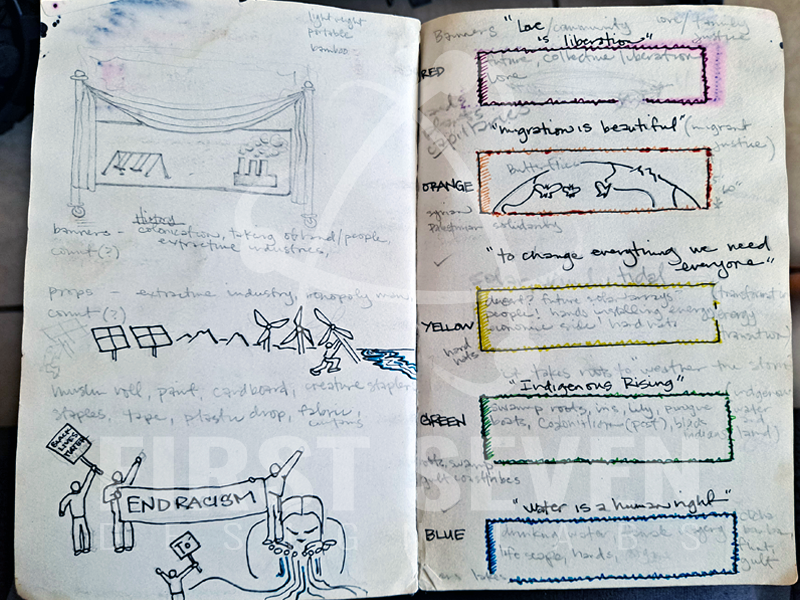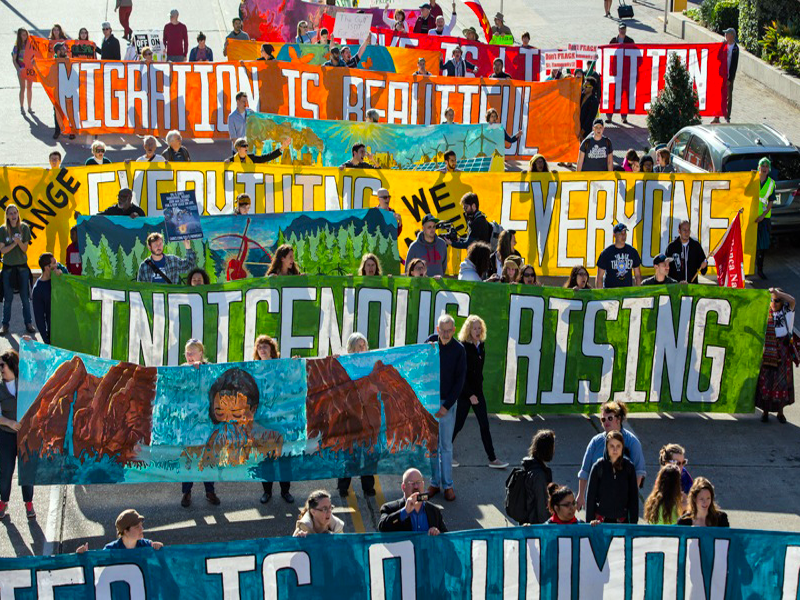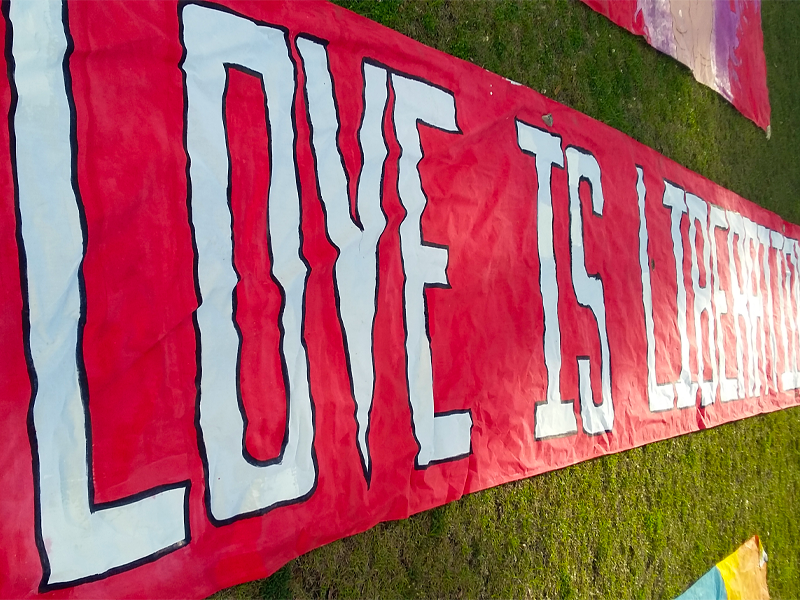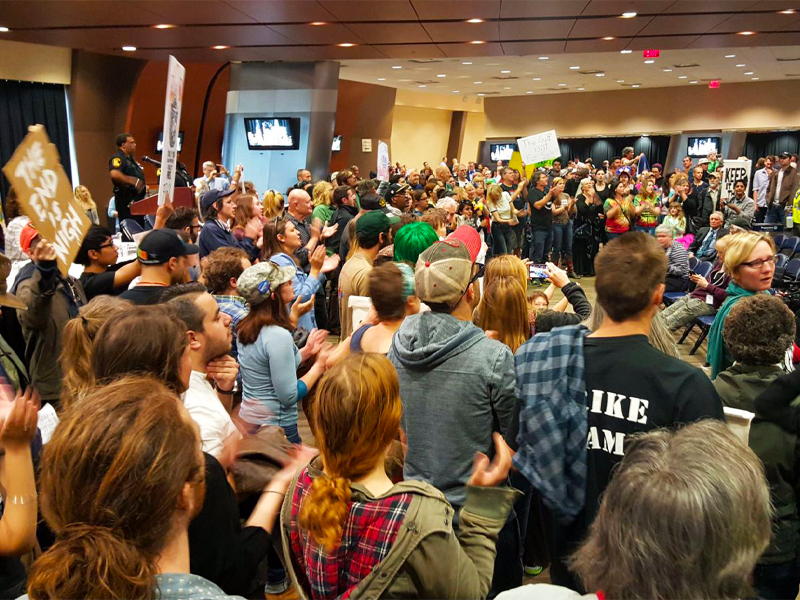President Obama recently opened 43 million acres in the Gulf of Mexico for oil and gas drilling at a lease sale in New Orleans. As an Indigenous Movement Artist, I was given the opportunity to work with directly impacted People of Color from the Gulf in the lead-up to an oil and gas auction.
This particular target involved a lease sale happening at the Superdome in New Orleans which has historically been the site of much grief and sadness. After some research, I presented an action scene that attempted to encapsulate the Superdome itself and the many stories and struggles of the Gulf and its residents before Hurricane Katrina.


The scenario turned the New Orleans Superdome into a giant carousel with visual and text banners dedicated to the different calls to action being highlighted. There were different colors associated with each banner creating a rainbow of stories that were rooted in transformative justice and healing the community was advocating for. The local grassroots accepted my design proposal and I was flown in to pull this off. There were many challenges on this project which was very bold in terms of the art, artists and the small number of community that would be showing up for the action.




Our banners were not drying in the humidity of NOLA so I devised a mechanism to raise them into the rafters of the warehouse where the art was being created in. Late nights and early mornings had the artists constantly busy. Behind the scenes, native nonprofits and other local organizers would devise ways to claim this creativity as their own, some organizers even until this day. This example can provide a learning moment for the movement moving forward in terms of community accountability. When claiming work as an artist, original designs and sketches should always be provided without request.
I wasn’t aware at the time but the following interactions would encapsulate my experiences working with native nonprofits. The green visual banner for the Indigenous contingent in the Gulf was designed and in the process of being painted however, local natives struggled with the text banner messaging associated with it. There were only so many letters physically allowed on the banner so grassroots community messaging had to be limited to a few words.
It was conveniently suggested by a media personality from Indigenous Environmental Organization (IEN) that the text banner be titled, “Indigenous Rising” which happened to fit the sizing needed. However, what wasn’t known to the local Indigenous people until after the event was that “Indigenous Rising” was a native media company that was just started under IEN. This was blatant theft of the Indigenous messaging from the Gulf and relegated their historical struggle to nothing more than a commercial for their janky native nonprofit news corporation. This type of capitalist opportunism is built into the patriarchal relationship between 350.org and IEN, therefore, this new nepotistic spin-off was never going to be any different.
In large deployments, working through the night before the action is usually standard practice. This allows time to sew up the last-minute details and art. The visual portion of the banners was behind schedule sending the creative process into overdrive which was a zone I love to indulge tapping into. Adding lack of sleep made this time and space seem like on a different plane altogether and this creative energetic zone was indulged in and enjoyed until morning.
When we arrived on location on the morning of the action, the banners were laid out for the public to see and pick up to carry to the Superdome. I made note of some unusual attention the Indigenous green text banner was getting. Upon walking over it was these same parachuting snakes from the native media nonprofit posing with the text banner that hijacked and stole the local native messaging and voices. When recalling, that moment was filled with strange uneasy energy that I couldn’t put my finger on but of course, now makes perfect sense.

After the morning prayers and speakers, protestors marched with the banners to the Superdome. The morning light was to their backs which illuminated the march at the moment of arrival at the oil and gas auction. These pictures would go viral. Despite prior requests for art credit this was not fulfilled until after the event which greatly diminishes exposure at the time of impact. This can be detrimental to a BIPOC artist’s continued work who doesn’t have the luxury of a corporate salary.

Upon reaching the Superdome protestors made their way inside the auction to shut it down. They voiced that the Bureau of Ocean Energy Management’s social impact analysis of the Deepwater Horizon disaster did not include the public health consequences of their spill and the cleanup. Environmental grievances took center stage by everyone involved and the police were called to mitigate by arrests. After the auction was shut down, protestors made it above to the deck of the Superdome to march and fulfill the final media aspects of the actions which included a helicopter.
Many federal oil and gas leases on public lands during this time were disrupted and delayed. Some tactics leveraged white privilege by attending auctions and bidding on millions of dollars worth of lease sales with no plan to pay for them . This was the first protest organized around lease sales in the public waters of the Gulf.
Communities of color that live along the Gulf near oil refineries are exposed to the pollution emitted by these refineries. The EPA adopted new rules on air pollution from oil refineries in 2015, but residents and environmental activists would prefer to see an end to the oil industry altogether in the Gulf.
Unfortunately, the protest did not delay Wednesday’s sale. More than 24 oil and gas companies submitted 148 bids for the leases, which encompass waters off the coast of Louisiana, Mississippi, and Alabama. As of now, there are about 4,400 active leases in the Gulf of Mexico under BOEM’s control.




















Comments are closed.